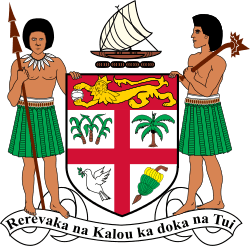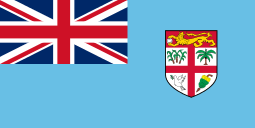Dominion of Fiji
| Dominion of Fiji | ||||||||||
| ||||||||||
| ||||||||||
| Motto "Rerevaka na Kalou ka Doka na Tui" "Fear God and honour the Queen" | ||||||||||
| Anthem God Bless Fiji Royal anthem God Save The Queen | ||||||||||
.svg.png) | ||||||||||
| Capital | Suva | |||||||||
| Languages | English Fijian | |||||||||
| Government | Constitutional monarchy | |||||||||
| Monarch | ||||||||||
| • | 1970–1987 | Elizabeth II | ||||||||
| Governor-General | ||||||||||
| • | 1970–1973 | Robert Sidney Foster | ||||||||
| • | 1973–1983 | George Cakobau | ||||||||
| • | 1983–1987 | Penaia Ganilau | ||||||||
| Prime Minister | ||||||||||
| • | 1970–1987 | Kamisese Mara | ||||||||
| • | 1987 | Timoci Bavadra | ||||||||
| Legislature | Parliament | |||||||||
| • | Upper house | Senate | ||||||||
| • | Lower house | House of Representatives | ||||||||
| Historical era | Cold War | |||||||||
| • | Independence | 10 October 1970 | ||||||||
| • | Republic proclaimed | 6 October 1987 | ||||||||
| Area | ||||||||||
| • | 1976 | 18,274 km² (7,056 sq mi) | ||||||||
| Population | ||||||||||
| • | 1976 est. | 588,068 | ||||||||
| Density | 32.2 /km² (83.3 /sq mi) | |||||||||
| • | 1986 est. | 715,375 | ||||||||
| Density | 39.1 /km² (101.4 /sq mi) | |||||||||
| Currency | Fijian dollar | |||||||||
| Calling code | +679 | |||||||||
| ||||||||||
| Today part of | | |||||||||
The Dominion of Fiji was the official name of Fiji between October 1970 and 6 October 1987. When British rule ended in 1970, the Fijian Islands were given independence as a Dominion, in which the British monarch, Elizabeth II, remained head of state as Queen of Fiji, represented by the Governor-General. The Republic of Fiji, removing Elizabeth II as head of state, was proclaimed on 6 October 1987 after two military coups. During the Dominion period, the following Governors-General held office:
- Sir Robert Sidney Foster 10 October 1970 – 13 February 1973
- Ratu Sir George Cakobau 13 February 1973 – 12 February 1983
- Ratu Sir Penaia Ganilau 12 February 1983 – 6/15 October 1987
The following held office as prime minister (and head of government) of the Dominion of Fiji:
- Ratu Sir Kamisese Mara 10 October 1970 – 13 April 1987
- Timoci Bavadra 13 April 1987 – 14 May 1987
Elizabeth II visited Fiji before its independence in 1953, 1963 and March 1970, and after independence in 1973, 1977 and 1982.
Following the election of the ethnically Indian-dominated government of Prime Minister Timoci Bavadra (although he personally was an indigenous Fijian) on 13 April 1987, Lieutenant Colonel Sitiveni Rabuka carried out the first of two military coups on 14 May 1987. At first, Rabuka expressed loyalty to Queen Elizabeth II. However, Governor-General Ratu Sir Penaia Ganilau, in an effort to uphold Fiji's constitution, refused to swear in the new (self-appointed) government headed by Rabuka, and so Rabuka declared a republic on 6 October 1987. This was accepted by the British government on 15 October 1987, and Ganilau resigned on the same day. In a letter addressed to Queen Elizabeth II, Ganilau wrote:
"With humble duty, I wish to submit to you the following advice, acting in my capacity as your representative in Fiji. Owing to the uncertainty of the political and constitutional situation in Fiji, I have now made up my mind to request Your Majesty to relieve me of my appointment as Governor-General with immediate effect. This I do with utmost regret, but my endeavours to preserve constitutional government in Fiji have proved in vain, and I can see no alternative way forward. With deepest respect, Penaia Ganilau, Governor-General."
Following the establishment of a republic, former Governor-General Ratu Sir Penaia Ganilau became the first President of Fiji, in December 1987.
Part of a series on the |
|---|
| History of Fiji |
 |
| Early history |
| Modern history |
| Coup of 2000 |
| Proposed Reconciliation Commission |
| Crisis of 2005–06 |
| Coup of 2006 |
References
- http://www.archontology.org/nations/fiji/01_polity.php
- http://www.archontology.org/nations/fiji/00_1970_87_g.php
- http://www.worldstatesmen.org/Fiji.html
- http://www.paclii.org/fj/legis/num_act/fc1970rd1987343/
